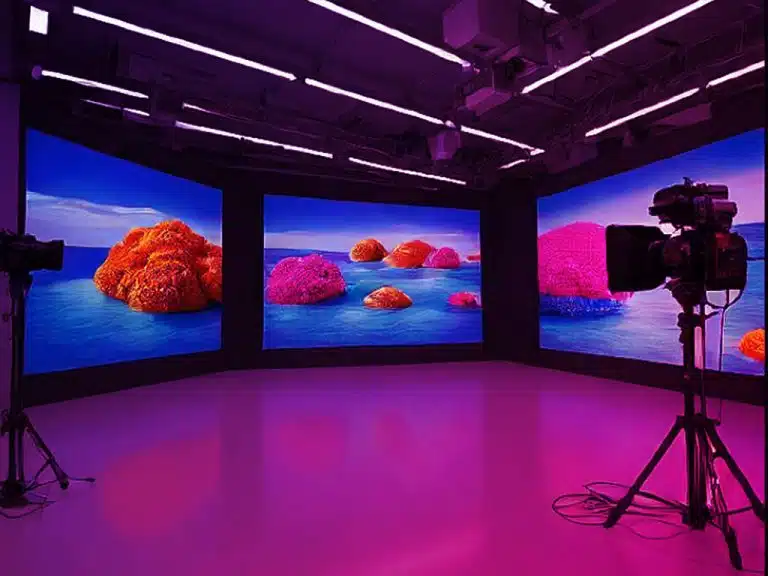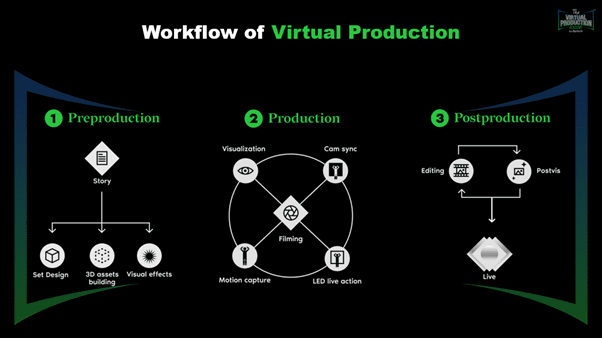Getting Started with Virtual Production: A Beginner's Guide
Virtual production has taken the film and entertainment industry by storm in recent years. What was once reserved for big-budget Hollywood productions has become more accessible to independent filmmakers and content creators in India. This technology allows filmmakers to create stunning and immersive environments, characters, and scenes without ever leaving the studio.
Even to spice it up for the enthusiastic commoners, Aptech has opened a virtual production course India where you can be getting virtual production certificate upon the course completion. Interesting right!?
CONNECT WITH US
If you’re a beginner & interested in futureproofing your career similar to completing your masters in filmmaking a strong recommendation, explore the world of virtual production & this guide is for you. We’ll take you through the basics, the tools you’ll need, and the steps to get started in this exciting field.
What is Virtual Production?
Before diving into the details, let’s start with the basics. Virtual production is a filmmaking technique that blends physical and digital elements to create a seamless on-screen experience. It enables filmmakers to combine live-action footage with computer-generated imagery (CGI) in real-time. This process can involve techniques like motion capture, green screens, and real-time rendering to transport audiences to any location or era. In simpler terms, 3D environments are created and projected on massive LED Volume Walls to create a real likelocation and with the help of camera calibration, a scene is shot.
Virtual production gained significant recognition in the industry with movies like James Cameron’s “Avatar” and Jon Favreau’s “The Mandalorian.” However, thanks to advancements in technology, it’s no longer confined to large studios with massive budgets.
Essential Components of Virtual Production
To get started with virtual production, you’ll need several key components and tools:
1. Green Screens or LED Walls
Green screens are the most traditional backdrop for virtual production. However, LED walls have become increasingly popular due to their ability to provide real-time, in-camera backgrounds and reflections. LED walls are more expensive but offer a more immersive experience.
2. Cameras
High-quality cameras are the foundation of any production. You can use traditional cinema cameras or specialized virtual production cameras equipped with motion capture technology for real-time integration with CGI.
3. Real-Time Rendering
Real-time rendering engines, such as Unreal Engine or Unity, are used to generate and display digital backgrounds and characters on LED walls or in post-production. These engines enable you to see how everything will look in real time.
4. Virtual Production tools
Various software tools and platforms are designed specifically for virtual production. They include camera tracking software, compositing software, and virtual set design tools. The generic of the shelf tools includes Autodesk Maya, Blender, Adobe Substance Painter, and Unreal. For Camera Tracking Solution mention Vive Mars Cam Track, NCam, Mo-Sys. Since we are using Vive Mars there will be co-relation. For compositing mention both Foundry Nuke & Adobe After Effects.
5. Lighting and Sound
Even in a virtual environment, lighting and sound are essential for creating a believable and immersive world. Invest in quality lighting equipment and sound recording devices to enhance your production’s realism.
6. Motion Capture
Motion capture technology records the movements and actions of actors and objects, allowing them to be translated into digital characters and animations. This is crucial for creating realistic CGI elements. (mostly used in games and in abroad- king kong, planet of apes)

Steps to Get Started in Virtual Production
Now that you have a basic understanding of the components involved in virtual production, let’s walk through the steps to get started:
Budgeting
Virtual production can be cost-effective compared to traditional methods, but it’s not without expenses. You’ll need to budget for equipment, studio space, software licenses, and a skilled team. Plan your budget carefully to ensure that you can achieve your creative vision without overspending
1. Learn the Basics of Filmmaking
Before diving into virtual production, it’s essential to have a strong foundation in traditional filmmaking techniques. Understand cinematography, storytelling, and visual composition. This knowledge will serve as the bedrock of your virtual production journey.
2. Familiarize Yourself with Virtual Production Tools
Take the time to explore the software and hardware required for virtual production. Learn how to operate cameras, motion capture equipment, and real-time rendering engines. There are numerous online courses, tutorials, and workshops that can help you become proficient in these tools.
3. Develop a Concept
Just like in traditional filmmaking, start with a compelling concept for your project. Decide whether you want to create a short film, a music video, a commercial, or something else. The concept will drive the creative and technical decisions throughout your production.
4. Assemble Your Team
Virtual production is a collaborative effort. You’ll need a team that includes directors, producers, cinematographers, VFX artists, and sound engineers. Work with professionals who have experience in the virtual production field to ensure a successful project.
5. Set Up Your Studio
Create a dedicated virtual production studio space with the necessary equipment, including cameras, motion capture tools, LED walls, and lighting. Ensure your space is suitable for both live-action filming and real-time rendering.
6. Previsualization
Before shooting, use previsualization tools to plan your scenes. This involves creating a digital storyboard or animatic to guide your team during the shoot. It’s an essential step for ensuring that the live-action elements align with the CGI. There are 1ooo+ possibilities in a particular scene in previz- 10 min scene with zero cut can be shot in pre-visualization.
7. Shooting
Once your studio is set up, begin the shooting process. Whether you’re using green screens or LED walls, make sure to capture high-quality footage. Pay attention to lighting, sound, and the synchronization of live and virtual elements.
8. Post-Production
In post-production, combine your live-action footage with CGI using compositing software. Fine-tune the visuals and audio to create a seamless and compelling final product.
9. Distribution
After completing your project, decide on your distribution strategy. Will you screen your production in theaters, release it on streaming platforms, or share it on social media? Tailor your distribution plan to your target audience.
How to expand the Skill Set?
As you gain experience in virtual production, consider expanding your skill set in the following areas:
1. Continuous Learning
Virtual production is a constantly evolving field. Stay updated with the latest technologies, software updates, and industry trends. Join virtual production communities, attend conferences, and collaborate with fellow filmmakers to keep learning and growing in the field.
2. Scriptwriting for Virtual Environments
Writing a script that seamlessly integrates live-action and virtual elements requires a different approach. Consider how your story can leverage the capabilities of virtual production to enhance the narrative.
3. Real-Time Rendering
Mastering real-time rendering engines like Unreal Engine or Unity can be a significant asset. Familiarize yourself with their capabilities and limitations to make informed creative decisions.
4. VFX and CGI
Acquiring knowledge in visual effects (VFX) and computer-generated imagery (CGI) will enable you to create more sophisticated and visually stunning virtual environments and characters.
5. Post-Production and Editing
Even in the world of virtual production, post-production and editing are essential. Learn how to fine-tune your footage, add visual effects, and perfect the sound design.

Staying Inspired
Virtual production is a constantly evolving field, and it’s essential to stay inspired and informed. Here are some ways to do that:
Watch Virtual Production Content
Study movies and TV shows that have effectively used virtual production techniques. This will give you insights into what’s possible and inspire your creativity. by analusizibf shots understand color grading, depth of scene, camera length, and physical set extensions.
Attend Workshops and Virtual Production Academy Courses
Workshops are great places to learn from experts. Network with like-minded individuals, and discover the latest trends and innovations. Take up virtual production programs that are informative and educative. These platforms are excellent for clear doubts, sharing your work, and getting feedback from experienced practitioners.
Conclusion
Virtual production is an exciting and accessible way to create visually stunning and immersive content. As a beginner, it’s important to start with a solid foundation in traditional filmmaking, understand the essential components, and invest time in learning the necessary tools and techniques. With dedication, practice, and a creative vision, you can use virtual production to tell compelling stories and bring your imagination to life on the screen. So, grab your camera, get creative, and embark on your virtual production journey today!
